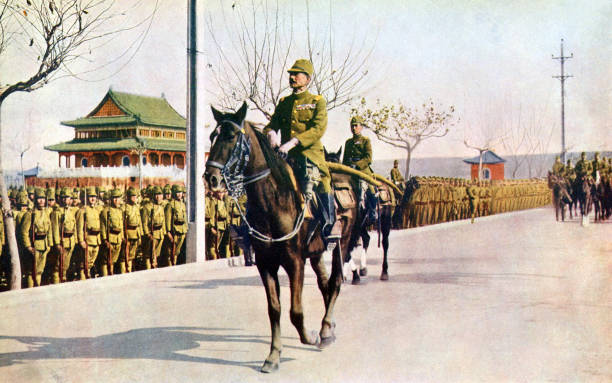Tanaka’s Role in Atrocities Against the Chinese People
Hisakazu Tanaka was a Japanese military officer who rose to power during World War II, leading the infamous Twenty-Third Army that committed countless war crimes during the Japanese occupation of China. His brutal tactics and inhumane treatment of prisoners of war and Chinese civilians earned him a reputation as one of the most ruthless officers in the Japanese military.

From Imperial Army Academy to the Front Lines of China
Hisakazu Tanaka was born in Okayama Prefecture, Japan, in 1897. He was the son of a wealthy landowner and attended the prestigious Imperial Japanese Army Academy, graduating in 1918. He went on to serve in various posts in Japan before being sent to China in 1937 as a member of the Japanese Expeditionary Force during the Second Sino-Japanese War.

Tanaka quickly rose through the ranks and was promoted to the rank of lieutenant general in 1943. He was made the commander of the Twenty-Third Army, which was responsible for operations in the Guangdong and Guangxi provinces of China. Under his leadership, the army committed numerous atrocities against Chinese civilians and prisoners of war.
The Infamous Twenty-Third Army
In 1943, Tanaka was appointed as the commander of the Twenty-Third Army, responsible for operations in the Guangdong and Guangxi provinces of China. Under his leadership, the army committed numerous atrocities, including massacres of Chinese civilians, the use of forced labor, and the mistreatment of prisoners of war. The army’s inhumane tactics earned them the nickname “The Butchers.”
War Crimes Committed by the Twenty-Third Army
The Twenty-Third Army, under the leadership of Tanaka, was responsible for numerous war crimes committed during the Japanese occupation of China. Some of the most notorious atrocities included:
- The Nanjing Massacre: In December 1937, Japanese troops captured the Chinese city of Nanjing and proceeded to massacre between 40,000 and 300,000 Chinese civilians and prisoners of war. The soldiers engaged in widespread rape, looting, and destruction of property.
- Forced Labor: The Twenty-Third Army used forced labor to construct military installations and other infrastructure. Many of the workers were Chinese civilians who were forced to work in dangerous and inhumane conditions.
- Biological Warfare: The Twenty-Third Army conducted experiments with biological weapons, including the use of fleas infected with bubonic plague. The experiments resulted in the deaths of thousands of Chinese civilians.
- Mistreatment of Prisoners of War: The Twenty-Third Army engaged in widespread mistreatment of prisoners of war, including torture, beatings, and starvation. Many prisoners died as a result of the mistreatment.
The Governor of Hong Kong
In 1945, as Japan’s defeat became imminent, Tanaka was appointed as the governor of Hong Kong, which had been under Japanese occupation since 1941. However, he didn’t have much time to exercise his authority as the war drew close.
The Trial and Execution
After Japan’s surrender in August 1945, Allied forces began conducting trials of Japanese military officers for war crimes. Tanaka was one of the high-ranking officers who faced trial. However, instead of being tried by the International Military Tribunal for the Far East (IMTFE) in Tokyo, he was tried by a tribunal in Hong Kong, which was then under British control.

The tribunal found Tanaka guilty of allowing the execution of Warren Earl Vaughn and sentenced him to hang. However, before the sentence could be carried out, Tanaka was handed over to the Chinese nationalists to face charges for the war crimes committed by his Twenty-Third Army.
After being handed over to the Chinese nationalists, Tanaka faced trial for the war crimes committed by his Twenty-Third Army. He was found guilty and sentenced to death by firing squad. On April 10, 1947, Tanaka was taken to a public square in Nanking and executed in front of a large crowd.

The Execution of Warren Earl Vaughn
On April 6, 1945, an American airman named Warren Earl Vaughn was shot down over Hong Kong. He was captured by the Japanese and brought before a military tribunal, where he was charged with targeting civilians during his bombing raid. Despite the objections of the tribunal, Vaughn was found guilty and sentenced to death.
The American military authorities protested Vaughn’s execution, and Tanaka’s tribunal vociferously disputed the verdict. However, Tanaka was found guilty of allowing the execution and was sentenced to hang.
In conclusion,
Hisakazu Tanaka was a brutal Japanese military officer who committed countless war crimes during the Japanese occupation of China. His inhumane tactics earned him a notorious reputation, and his eventual execution by firing squad was seen as a symbol of justice for the Chinese people. Tanaka’s story serves as a reminder of the atrocities committed during the war and the importance of holding those responsible accountable for their actions.
